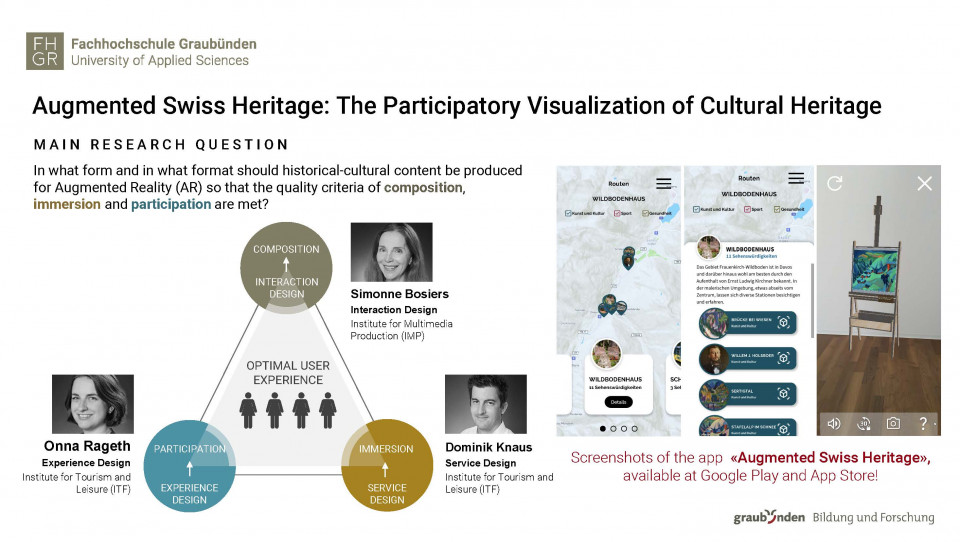Augmented Reality: In this project, an AR app for guests and locals of the destination Davos is being created in collaboration with the Kirchner Museum and the Davos Museum of Local History. With the app, the guest experiences Davos' cultural heritage in an immersive and participatory way. In terms of time and content, the app is to be closely linked to the exhibition Europa auf Kur, in which the rise of Davos from a sleepy mountain farming village to a sophisticated spa and tourist resort as well as a meeting point for the European scientific and cultural scene is highlighted. The project pursues to answer three questions:
Which art historical artifacts, tourist sites and stories are suitable for augmentation (enrichment) on the smartphone?
Which multimedia forms and formats have to be applied to the virtual content in order to fulfil the quality criteria of composition, immersion and participation?
Which steps of the production process can be defined and to what extent can the latter be optimised to deliver a high-quality result in a cost-effective and timely manner?
The project investigates how sights, art, history as well as tangible and intangible social-cultural knowledge about Switzerland can be made accessible through AR in the form of new user experiences for a tech-savvy target group. It explores and elaborates the production process from curating the content to digital augmentation and delivery to the smartphone app and ultimately its distribution through the platform discover.swiss, providing a template for replicability by other destinations.
Methodology: The innovation consists of making content that is hardly known or accessible to humans, avail- able to them and of presenting this virtual content audio-visually in a composition with reality. Young people in particular dislike reading long texts and prefer visual presentations. Consequently, the aspect of scene composition is very important. Ronald Azuma (1997) succinctly defines it as follows:
«AR allows the user to see the real world, with virtual objects superimposed upon or composited with the real world. Therefore, AR supplements reality, rather than completely replacing it. Ideally, it would appear to the user that the virtual and real objects coexisted in the same space».
Immersion is equally important in AR than in VR. Two factors must be ensured: The «illusion of place» and the «illusion of plausibility» (Slater 2009). «Illusion of place» requires that the user really has the feeling of being in the virtual place. The «illusion of plausibility» is given when the users get the feeling that the events around them are true.
The current state of research regarding especially intangible cultural heritage suggests that, at a deeper level, commodification of heritage can be interpreted as marking needs for identity, and the finding of the true self through the appropriation of pastness (McIntosh and Prentice 1999, 590). In general, there has thus far been little emphasis on the consumers’ perspective or, indeed, that consumers have different perspectives, expectations, and needs (de Faucon-berg, Berthon and Berthon 2017, 6). Heritage sites are often built on the memories and remains of previous societies and production processes but are given new meanings in contemporary contexts (Heldt Cassel and Pashkevich 2014, 1625). Consequently, the presented research project closes a gap in research regarding its methodological approach; researchers from UAS of the Grisons form a so-called «community of practice» with well-informed stakeholders (mainly locals), which allows the fostering of associations and ultimately, the generation of new and highly transdisciplinary data (Gautier et al. 2021).
Technology (Gain of knowledge): In the pilot phase, a smartphone app (Android, iOS) is used, but the goal is a progressive web app (PWA). The app enables users to view 2D/3D animated and/or interactive digital models, (persistent content). All users can view the same model in the same place (shared content, allowing to design experiences for families and groups). The content is located on discover.swiss, an open back-end service platform based on Microsoft Azure Spatial Anchors for locating the models and AR Cloud for retrieving the models.
Social Relevance: The project brings Switzerland's cultural and historical heritage, both tangible and intangible, to the public in an educational and entertaining way and raises awareness among the Swiss population for novel technologies. With the app and the various augmented Swiss Heritage experiences, artwork, buildings, and various other artefacts that have disappeared or have been damaged are made visible and tangible in their full glory. Events come to life; guests can even be taken on a journey through time. It is precisely the quality feature of participation that promotes the social and societal sustainability outlined here, as active participation and engagement with content from history, politics, natural and cultural history, or art are specifically supported. In addition, an innovative contribution is made to the preservation of the material and immaterial heritage of Switzerland.
References:
Azuma, R. T. (1997). A Survey of Augmented Reality. Presence: Virtual and Augmented Reality, 6(4): 355-385.
de Fauconberg, A., Berthon, P. and Berthon, J.P. (2017). Rethinking the marketing of World Heritage Sites: Giving the past a sustainable future. Journal of Public Affairs, 1-7.
Gautier, A., Pache, A.-C, Chowdhury, I. & Ligonie, M. (2021). «The Missing Link: Communities of Practice as Bridges Between Institutional Entrepreneurs and Frontline Practitioners in Institutionalizing a Divergent Practice». Lounsbury, M., Anderson D. A. & Spee, P. (Ed.). On Practice and Institution: New Empirical Directions (Research in the Sociology of Organ- izations, Vol. 71). Emerald Publishing Limited: Bingley, 199-230.
Heldt Cassel, S. and Pashkevich, A. (2014). World Heritage and tourism innovation: Institutional frameworks and local adaptation. European Planning Studies, 22(8), 1625-1640.
McIntosh, A.J. and Prentice, R.C. (1999). Affirming authenticity: Consuming cultural heritage.
Annals of Tourism Research, 26(3), 589-612.
Slater, M. (2009). Place illusion and plausibility can lead to realistic behaviour in immersive virtual environments. Slater M. (2009). Place illusion and plausibility can lead to realistic behaviour in immersive virtual environments. Philosophical transactions of the Royal Society of London. Series B, Biological sciences, 364(1535): 3549–3557.
